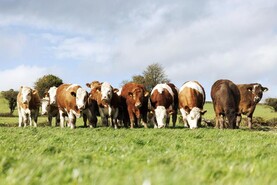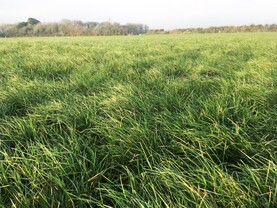Dispatch documents: Factory agents and mart managers report a rise in the number of farmers presenting sheep for sale accompanied with old dispatch documents. It is happening most often with store lamb finishers, some of whom report they had missed updates relating to the new dispatch booklets when they were circulated. It is important to check that you are using the correct booklet, as sheep cannot be traded with old dispatch documents. Your local district veterinary office should be contacted regarding lost booklets and ordering new booklets.
Tag numbers do not need to be recorded on dispatch documents where sheep are traded through a central point of recording (CPR). The five main export plants – Dawn Meats, Irish Country Meats Camolin and Navan plants, Kepak Athleague and Kildare Chilling are all registered as a CPR.
There are eight marts listed on the Department online CPR listing: Burke’s (Maam Cross) Livestock Mart, Carnaross Mart, Clare Co-operative Marts, Cork Co-operative centres in Cahir, Fermoy and Macroom, Inishowen Co-op Society Livestock Mart and Waterford Ross Marts LTD.
Factory procurers are also reminding farmers to be careful of lambs falling foul of the clean livestock policy (CLP), with more lambs being rejected for slaughter reported following heavy rainfall. The highest risk category continues to be lambs with a soiled, wet fleece. In such cases, there is a much greater chance of lambs that would normally fall into category B if their fleece was dry, being classified as category C and being rejected for slaughter.
Carrying capacity of forage crops: This week’s sheep feature on page 36 looks at a new trial assessing the role of forage crops in finishing store lambs. To calculate the volume of feed available, firstly cut and weigh a 1m2 section of the crop. If there is significant variability, take more than one cutting. Multiply the weight by 10,000 as there are 10,000m2 in a hectare.
This is the volume of forage available on a fresh weight basis. The dry matter (DM) content of forage rape or hybrid brassica crops is typically 12% to 14%, but this can dip lower in prolonged wet periods. Using an example of 3.2kg fresh weight in the 1m² section and a DM of 12% gives a fresh weigh yield of 3.84t (3.2kg * 10,000 * 12%).
Account needs to be taken of variance in utilisation. Typically, this averages around the 70% to 75% mark when ground conditions are reasonable, but it can drop to between 40% to 50% during inclement weather and even lower in poor draining soils. Taking utilisation of 70% gives 2.69t of available feed.
Lowland lambs weighing in the region of 35kg to 44kg have a dry matter intake potential of 1.25kg DM, while light hill lambs weighing 28kg to 35kg have an intake potential about 70% lower (0.9kg to 1kg) with mature ewe intake much higher at 1.6kg DM.
It is recommended that 30% of the diet should be made up of an additional forage or fibre source to help prevent digestion problems. Some farmers feed concentrates to store lambs and hay, straw or silage to ewes. Taking a lamb weighing 40kg and 0.3kg of their 1.25kg daily DM intake being met by concentrates, there are 2,381 grazing days. In simpler terms, if 100 lambs are grazing, the crop will last just over 28 days.
Dispatch documents: Factory agents and mart managers report a rise in the number of farmers presenting sheep for sale accompanied with old dispatch documents. It is happening most often with store lamb finishers, some of whom report they had missed updates relating to the new dispatch booklets when they were circulated. It is important to check that you are using the correct booklet, as sheep cannot be traded with old dispatch documents. Your local district veterinary office should be contacted regarding lost booklets and ordering new booklets.
Tag numbers do not need to be recorded on dispatch documents where sheep are traded through a central point of recording (CPR). The five main export plants – Dawn Meats, Irish Country Meats Camolin and Navan plants, Kepak Athleague and Kildare Chilling are all registered as a CPR.
There are eight marts listed on the Department online CPR listing: Burke’s (Maam Cross) Livestock Mart, Carnaross Mart, Clare Co-operative Marts, Cork Co-operative centres in Cahir, Fermoy and Macroom, Inishowen Co-op Society Livestock Mart and Waterford Ross Marts LTD.
Factory procurers are also reminding farmers to be careful of lambs falling foul of the clean livestock policy (CLP), with more lambs being rejected for slaughter reported following heavy rainfall. The highest risk category continues to be lambs with a soiled, wet fleece. In such cases, there is a much greater chance of lambs that would normally fall into category B if their fleece was dry, being classified as category C and being rejected for slaughter.
Carrying capacity of forage crops: This week’s sheep feature on page 36 looks at a new trial assessing the role of forage crops in finishing store lambs. To calculate the volume of feed available, firstly cut and weigh a 1m2 section of the crop. If there is significant variability, take more than one cutting. Multiply the weight by 10,000 as there are 10,000m2 in a hectare.
This is the volume of forage available on a fresh weight basis. The dry matter (DM) content of forage rape or hybrid brassica crops is typically 12% to 14%, but this can dip lower in prolonged wet periods. Using an example of 3.2kg fresh weight in the 1m² section and a DM of 12% gives a fresh weigh yield of 3.84t (3.2kg * 10,000 * 12%).
Account needs to be taken of variance in utilisation. Typically, this averages around the 70% to 75% mark when ground conditions are reasonable, but it can drop to between 40% to 50% during inclement weather and even lower in poor draining soils. Taking utilisation of 70% gives 2.69t of available feed.
Lowland lambs weighing in the region of 35kg to 44kg have a dry matter intake potential of 1.25kg DM, while light hill lambs weighing 28kg to 35kg have an intake potential about 70% lower (0.9kg to 1kg) with mature ewe intake much higher at 1.6kg DM.
It is recommended that 30% of the diet should be made up of an additional forage or fibre source to help prevent digestion problems. Some farmers feed concentrates to store lambs and hay, straw or silage to ewes. Taking a lamb weighing 40kg and 0.3kg of their 1.25kg daily DM intake being met by concentrates, there are 2,381 grazing days. In simpler terms, if 100 lambs are grazing, the crop will last just over 28 days.






 This is a subscriber-only article
This is a subscriber-only article










SHARING OPTIONS: